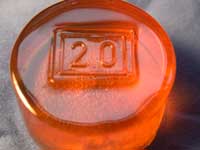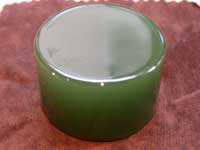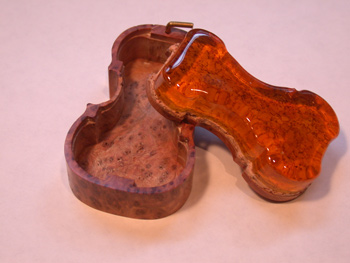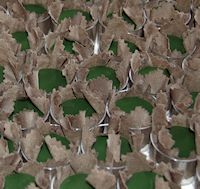 Regardless of the quality of your instruments, they will remain silent if you have no rosin. Worse yet, they will speak harshly if you have the wrong rosin.
Obviously, the quality of your rosin is critical.
During the second half of the 19th century, the French bow makers reached the top of their art. Their contemporary, Mr. S.A. Deroux, both a violin and a rosin maker, understood that it was urgent to create a superior rosin to enable these fine bows to make all fine instruments built until then sound perfectly - and so he did.
Many bow makers of this epoch didn't stamp their bows. Certainly, rosin makers did not.
 When Roger & Max Millant succeeded Mr. Deroux, they improved their rosin, and put the logo "M.D." on top of each rosin confirming that this rosin was made in the traditional way and that only the very best materials were used. They also knew that musicians prefer stamped rosins just as well as stamped bows. When Roger & Max Millant succeeded Mr. Deroux, they improved their rosin, and put the logo "M.D." on top of each rosin confirming that this rosin was made in the traditional way and that only the very best materials were used. They also knew that musicians prefer stamped rosins just as well as stamped bows.
How to make rosins
Perhaps you have thought; "I could make such a simple thing. I could make my own rosin. Save a little money, and make a little money on the side." Here are fool-proof directions; our "secret receipe" - for you! Free, no charge!
Use only legitimate ingredients that promote the clearness of the treble strings and the depth of sound on the bass side. Never use any hard substances that do not blend together with the natural ingredients. They will scratch the varnish of your "Strad" each time you clean it after playing. In any case, such ingredients have no adhesive power, which you need badly between bow and strings.
Raw materials:
 The extraction of resin from conifers has been going on since the dawn of time. In addition to its use in colophane, resin is also used as an adhesive and sealant.
Today, the primary crude resin is extracted from the pine, of which more than 100 species exist. Pine trees may be found all over Europe, Asia, North America and New Zealand. Many conifers, such as larches, spruces and firs are also used for extracting resin. These trees, however, yield considerably less resin. Their resin is used as trace elements in rosin, to control and modify tonal properties.
Rosin Extraction:
 The resin is extracted from the living tree, a process that does the tree no harm. Resin is not the tree´s "life-sap" - it serves only to seal off wounds. The wood also suffers no technical damage, as the "resined" area behind the area where the bark has been peeled off is restricted to a few millimetres. When the trunks are cut in order to tap the resin, these "rosined" pieces fall into the cut edges of the bark.
1) The first step in obtaining the resin is to remove the rough outer bark of trees which are to be tapped for the first time at a height of approximately 50 cm, at the beginning of the warmer season.
2) Use a special stirrup-shaped tool for scraping off the bark and making the drip channel
3) In the second step of the process, V-shaped grooves about 1 cm wide are cut into the thin inner layer of bark remaining after the first stage, using a plane. As a result of "wounding" the tree in this way, the resin begins to flow into the container hung under the cuts. The tree must be cut into again every 4-5 days.
4) Use a special tool for making the grooves cut in the surface of the trunk (plane, right side of tool) and for cleaning out the drip channel (left side)
Finishing:
 When you have composed your ideal formula, mix it up and put it in a large vat, over the fire. After the resins are completely melted, pour the hot, liquid rosin into moulds placed on marmore. After 30 minutes, your rosins are ready for finishing - but here is a problem you didn't expect. The top surface has now got a hollow that will prevent the bow hair from collecting rosin properly during the first two months of use. To correct this, reverse the  rosin after it is cool and completely hardened. Then you will have the ideal, flat surface. Now, polish this surface and put your stamp on it, confirming that it has been made personally by your self. Now afix the rosin to a soft cloth to protect your fingers. rosin after it is cool and completely hardened. Then you will have the ideal, flat surface. Now, polish this surface and put your stamp on it, confirming that it has been made personally by your self. Now afix the rosin to a soft cloth to protect your fingers.
Packing:
It is very important to use only tightly sealed containers. Rosin is like varnish - it dries during each month that passes. When buying rosin in a music shop you never know how long it has been waiting for you. The rosin will stay fresh for a very long time when it is not exposed to the air - no remelting needed.
If your home-made rosins are fantastic, you can start selling them. Just remember that if you sell to any C.E.E. country, you are obliged by law as of July 1, 1994 to furnish each rosin with a detailed listing of the resin it contains.
Last but not least: Don't be stingy - give your customer a full value for his money. A standard size of a rosin is almost 1 1/2 inch diameter (37 mm) and almost 1 inch tall (22 - 24 mm) |




















































 When Roger & Max Millant succeeded Mr. Deroux, they improved their rosin, and put the logo "M.D." on top of each rosin confirming that this rosin was made in the traditional way and that only the very best materials were used. They also knew that musicians prefer stamped rosins just as well as stamped bows.
When Roger & Max Millant succeeded Mr. Deroux, they improved their rosin, and put the logo "M.D." on top of each rosin confirming that this rosin was made in the traditional way and that only the very best materials were used. They also knew that musicians prefer stamped rosins just as well as stamped bows. rosin after it is cool and completely hardened. Then you will have the ideal, flat surface. Now, polish this surface and put your stamp on it, confirming that it has been made personally by your self. Now afix the rosin to a soft cloth to protect your fingers.
rosin after it is cool and completely hardened. Then you will have the ideal, flat surface. Now, polish this surface and put your stamp on it, confirming that it has been made personally by your self. Now afix the rosin to a soft cloth to protect your fingers.